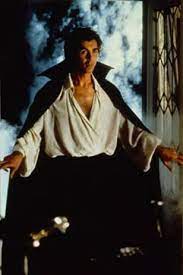
In Whitby, Yorkshire, 1913, Count Dracula (Frank Langella) arrives on the ship Demeter from Transylvania. Mina van Helsing (Jan Francis), visiting her friend Lucy Seward (Kate Nelligan), finds Dracula’s body near the shipwreck and rescues him. The Count visits Mina and her friends at the home of Lucy’s father Jack Seward (Donald Pleasance), which is also the local asylum. He impresses everyone at dinner, particularly Lucy, though her fiancé Jonathan Harker (Trevor Eve) is somewhat put out.
That night, while Lucy and Jonathan are having a tryst, Dracula descends upon Mina’s room and drinks her blood. Lucy finds her dying from what appear to be throat-wounds and blames herself. Doctor Seward call’s Mina’s father, Professor Abraham van Helsing (Laurence Olivier), who suspects vampirism. He and Seward find claw marks inside Mina’s coffin and investigate the local mines, where they find Mina undead and have to destroy her.
Lucy has been called to Carfax Abbey, where Dracula is living. She offers herself to him as his bride and begins to show symptoms of blood-loss. The doctors give her a transfusion, but she is still under Dracula’s spell. The doctors decide they must destroy Dracula. They find his coffin in Carfax Abbey, but he is waiting for them. Even in daylight, he is powerful, escapes from them, breaks into the asylum, where Lucy is under guard, and takes her away. He also kills his slave Milo Renfield (Tony Haygarth), thinking he betrayed him to van Helsing and Seward. He prepares to flee to Transylvania with Lucy, shipped as cargo in a coffin.
Harker and van Helsing board the ship. Van Helsing tries to stake Dracula, but Lucy wakes him. In the struggle, van Helsing is mortally wounded. As he dies, he impales Dracula on a cargo hook and Harker hoists it up into the rigging, where Dracula perishes in the sunlight. Lucy recovers, but she notices Dracula’s cape blowing away in the wind, and she smiles.
The film was directed by John Badham, based on Bram Stoker’s 1897 novel and the 1924 stage play, though the story concentrates heavily on Dracula’s animal magnetism and Langella’s sex appeal and catlike grace. It was filmed at Shepperton Studios and in Buckinghamshire and Cornwall. The cinematographer was Gilbert Taylor and the powerful score was written by John Williams. Sylvester McCoy (the eighth Doctor Who) had a minor role that was largely cut. The film won the 1979 Saturn Award for best horror film.
Frank Langella insisted there be no fangs dripping blood and he need not do any commercial promotions. He had been nominated for a Tony for playing Dracula on Broadway. His nystagmus, which made his eyes move erratically, did not seriously mar his performance, and sometimes he was able to overcome it with sheer force of will. Many men have since told him that their wives became extremely affectionate after watching the movie. Olivier suffered from an illness that, ironically, caused him to bleed excessively. Donald Pleasance would handle props or munch on sweets as he spoke his lines to make it difficult to edit his dialog. Jan Francis (Mina), who was a dancer, choreographed Dracula’s smoking hot dance with Lucy. Stuntman Eddie Powell had been Christopher Lee’s double on several Dracula films. Here, he doubled for Olivier. The whole film drips romanticism, the Edwardian sets are realistic, and you simply can’t take your eyes off Frank Langella.
